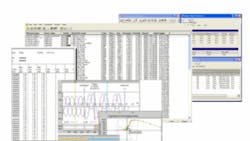Software for Automated Analysis of Faults and Protective Systems
FACES is a software for automated analysis of faults and protective systems in HV networks.
Fault analysis can be either an intensive work and/or a very long procedure in case of multiple or major disturbances in the high voltage power grid. In most cases, the operator has to go through all recorded data to identify the faults with a potential impact on the grid operation.
Some power companies are spending precious time and resources, dealing with system recovery while data are being collected and analyzed, and the faults located.
FACES is a tool designed to analyze faults and protection system with special emphasis on automatic selection of the most critical events, fault location as well as fault signature analysis. The key to the successful development of the tool comes from a long experience gained as manufacturer of Digital Fault Recorders (DFR) in close cooperation with electrical power system experts.
Data management
IED synchronization
The event summary can be painful in case of large power system failures. A good synchronization between various sources of data is essential for accurate and automated fault analysis. However, in practice and despite the development of GPS-based clock synchronization, a number of devices situated in the substations do not still provide accurate time stamped data. In this case, FACES will re-synchronize the selected records to provide a comprehensive view of the event ensuring precise fault analysis and decision making.
Prioritization of faults
Only a few events really need an in-depth analysis, most of them appearing as normal network operation. FACES uses an efficient classification method to automaticly select the faults considering the following criteria: current level, relay operating zone, location reliability, protection system response and auto-re-close operation. This allows to focus on the following issues:
- Prioritize the events with short circuit
- Select permanent fault rather than fugitive fault
- Locate the fault, with indication of the faulty phase(s)
- Understand the cause of the fault and help quick power restore in case of long line
Fault location
Accurate fault location information is essential for reliable operation of an electrical power system. The information can be used by both system operators and power system protection engineers. One significant aspect of power system restoration concerns the time spent to find the actual fault location along the line. But another aspect also involves re-closing performance following a circuit breaker operation. FACES deals with both aspects.
FACES implements multiple fault location algorithms: single-end with or without parallel line, or multiple ends. Depending on the type of fault and the data available, FACES selects the most relevant algorithm and delivers the most accurate fault location as well as a window of uncertainty around the calculated position.
Signatures analysis
FACES provides reliable data processing to distinguish a flashover caused by a lightning strike from tree or crane touching the line, bird collisions or polluted insulators (due e.g. to salty atmospheres, dust, snow, bird excreta, etc.). The digitized information comes from the available Intelligent Electronic Devices (IEDs) installed on the transmission overhead line system.
Protection system analysis
In addition to fault identification, FACES may evaluate the behavior of the protection system and compare it with performances expected by the electrical power public utility. Unexpected results may indicate bad settings or hidden failures and raise warnings or recommendations to the power system operators. These indications represent a significant improvement as they allow future fault prevention.
An adjustable solution
- Scalable deployment which can be adapted to the number of substations or the number of users
- Progressive integration into existing infrastructure
- Manufacturers independent solution compatible with multiple data sources (DFR, numerical relays, PMU)
Information within minutes
- Report layout built on user definable templates allowing report content customization to meet the needs of different users
- Event notification available to selected users by email or SMS when they are directly concerned
- Integration in utility Intranet
- SCADA system Interface
